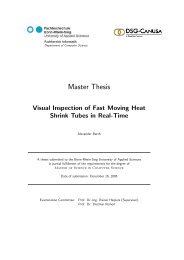Master Thesis - Hochschule Bonn-Rhein-Sieg
Master Thesis - Hochschule Bonn-Rhein-Sieg
Master Thesis - Hochschule Bonn-Rhein-Sieg
You also want an ePaper? Increase the reach of your titles
YUMPU automatically turns print PDFs into web optimized ePapers that Google loves.
5. Algorithms <strong>Master</strong> <strong>Thesis</strong> Björn Ostermann page 86 of 126<br />
transformation from pixel to real distance was programmed. This feature can be added in future work<br />
(see chapter 7.2).<br />
For the demonstration of this algorithm, impacting the robot’s current speed, the speed of the robot<br />
was reduced stepwise from 100% at 15 to 0% at 5 pixels distance. These values have to be adapted in<br />
future work, dependant on the respective safety analysis (see chapter 6.3).<br />
5.5 Robot path planning<br />
Building a collaborative workplace, a robot working together with humans, the basic solution is the<br />
described speed control from proximity measurement (see chapter 5.4). This basic solution<br />
implements the required safety, but it induces the problem that the robot often needs to wait for the<br />
humans to clear the working path before it can continue with its task. As described in chapter 2.3.1,<br />
planning a path for the robot around intruding objects in the workplace can reduce the time the robot is<br />
waiting. This optimization in collaboration is the main goal of this thesis.<br />
The path planning algorithm needs to control the robot’s complete process. A robot’s process consists<br />
of moving towards a desired goal in a certain way (direct drive, point to point) – the control of the<br />
trajectory – and in controlling the robot’s tools. Since the given robot was not equipped with any tools,<br />
the control of any tool was neglected. Adding a tool to the robot’s arm would change the physical<br />
boundaries of the robot. In this case, not only the tool handling would have to be implemented in the<br />
controlling program, but the change of the robot’s physique would have to be considered, when<br />
calculating the necessary safety distances during path planning (see chapter 6.3).<br />
To plan a path for the robot around intruding objects, the following points have to be considered:<br />
- The robot’s current position and its relation to the next goal position have to be known, in order<br />
to allow path control (see chapter 5.5.1).<br />
- The camera’s coordinate frame and the robot’s coordinate frame have to be determined and their<br />
relation has to be calculated. This is necessary to compare the robot’s position and its destination,<br />
which are both given in the robot’s coordinate frame, with those of the objects, which are given<br />
in the camera’s coordinate frame (see chapter 5.5.2).<br />
- The reachable space, the space the robot is allowed to reach, has to be determined (see chapter<br />
5.5.3) in order to allow the calculation of an evasion path (see chapter 5.5.5), if intruding objects<br />
are present in the path.<br />
Contrary to the speed control in chapter 5.4, where the information about the object’s and the robot’s<br />
position was solely acquired from the camera, the algorithms in this part rely on the robot’s internal<br />
sensors, to acquire its current position. While the speed control requires the actual shape of the robot,<br />
which is only delivered by the camera, the path planning can work on assumptions of the shape, which<br />
are computed from the robot’s position. The position acquisition from the robot’s internal sensors,<br />
apart from being more precise than the camera’s data, has the advantage of being considerably faster.














